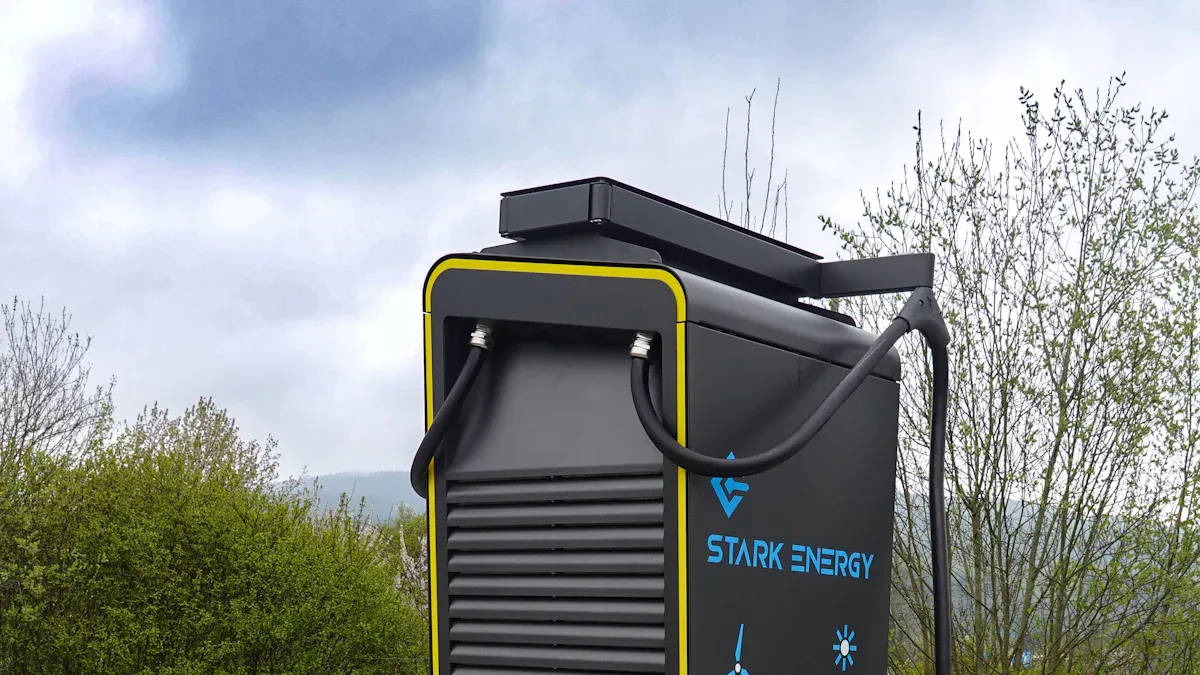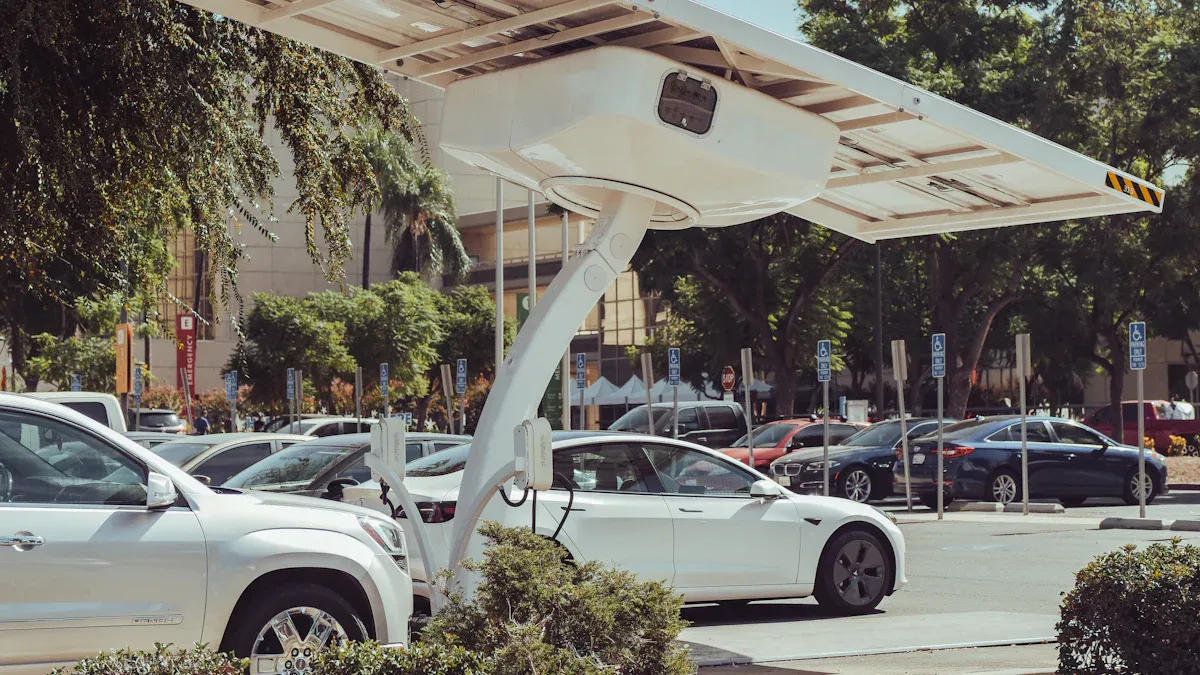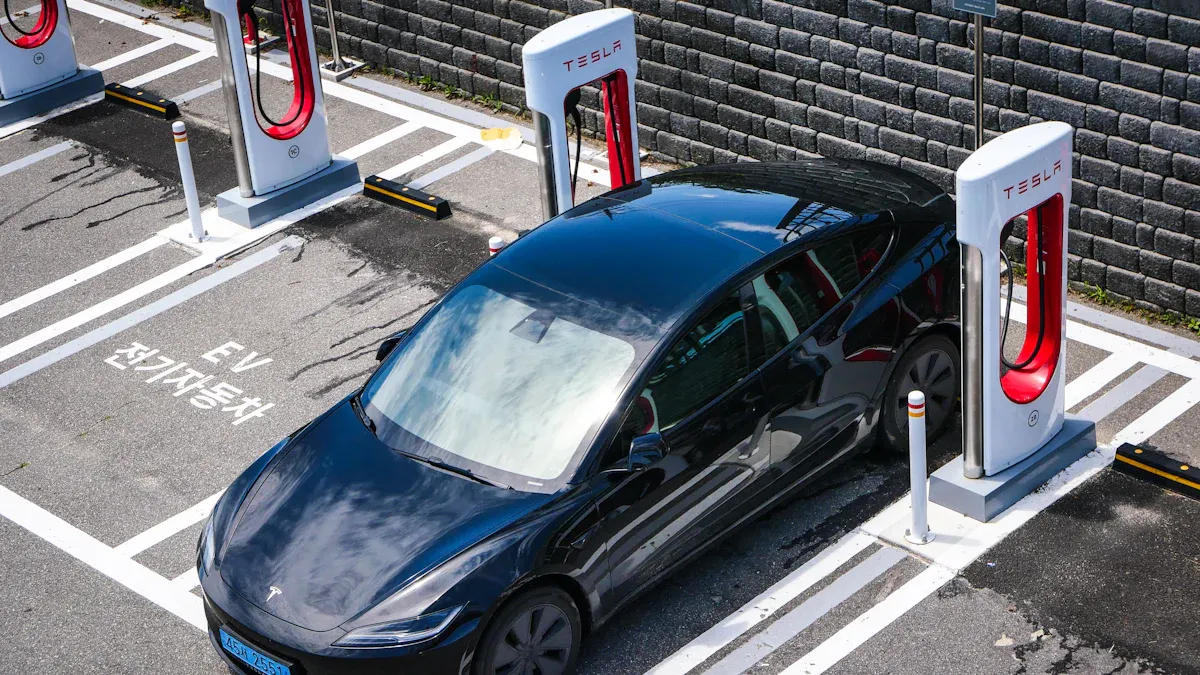
Power Distribution Units play a critical role in the efficient operation of EV charging stations. These devices distribute electricity to multiple charging ports while optimizing power flow to prevent overloads. As EV adoption accelerates—California alone aims for 5 million EVs by 2030—the demand for scalable, reliable PDUs continues to rise, ensuring infrastructure keeps pace.
Key Takeaways
- Power Distribution Units (PDUs) spread power to many EV chargers. They stop overloads and keep chargers working well.
- Buying PDUs that can grow helps charging stations handle more EVs. It also keeps up with new technology for the future.
- Dynamic Load Management (DLM) in PDUs shares energy smartly. It makes the grid stable and charging better during busy times.
What Are Power Distribution Units?
Definition and Purpose
Power Distribution Units (PDUs) are essential devices designed to distribute electrical power efficiently across multiple connected systems. In the context of EV charging stations, PDUs play a pivotal role in managing power flow to ensure consistent and reliable operation. These units prevent overloads by balancing the electrical load across various charging ports, which is critical for maintaining the performance of EV infrastructure.
PDUs also serve as a bridge between the electrical grid and EV chargers, optimizing power delivery to meet the demands of modern charging stations. Their purpose extends beyond simple power distribution; they enable monitoring, control, and scalability, making them indispensable for the growing EV market in the United States.
Note: As EV adoption continues to rise, the role of PDUs in ensuring efficient power management becomes increasingly significant.
Key Components and Features
Power Distribution Units incorporate several key components and features that enhance their functionality and reliability. These features are tailored to meet the specific needs of EV charging stations and other critical applications:
- Power Capacity: PDUs are designed to handle high electrical loads, ensuring they can support multiple EV chargers simultaneously.
- Input and Output Connections: Flexible connection options allow compatibility with various power sources and devices.
- Outlet Types and Configurations: Different outlet designs ensure seamless integration with EV chargers and other equipment.
- Monitoring and Management Capabilities: Advanced PDUs offer remote monitoring and control, enabling operators to track power usage and optimize consumption.
- Redundancy and Fault Tolerance: These features ensure uninterrupted power supply, even during equipment failures or electrical disruptions.
- Mounting Options and Form Factor: PDUs come in various configurations to accommodate diverse installation requirements, such as wall-mounted or rack-mounted designs.
- Surge Protection and Power Filtering: Built-in safeguards protect EV chargers and other connected devices from electrical surges and fluctuations.
Industry reports highlight that PDUs not only reduce overall power consumption but also minimize downtime, ensuring optimal performance for connected systems. These features make PDUs a cornerstone of efficient and reliable EV charging infrastructure.
Tip: When selecting a PDU for EV charging stations, operators should prioritize models with robust monitoring capabilities and fault tolerance to maximize efficiency and reliability.
How Power Distribution Units Support EV Charging Stations

Power Management and Load Balancing
Power Distribution Units play a vital role in managing power flow and balancing electrical loads at EV charging stations. These systems ensure that multiple chargers operate simultaneously without exceeding the capacity of the electrical panel. By distributing power efficiently, PDUs prevent overloads and maintain the reliability of the charging infrastructure.
Load management systems integrated into PDUs enable communication between chargers, allowing them to share electrical current dynamically. This feature is particularly beneficial for high-demand scenarios, such as commercial fleets or service-oriented vehicles, where uninterrupted charging is critical. For example:
- Load management systems allow multiple EV chargers to operate without exceeding the electrical panel’s capacity.
- These systems enable communication between chargers, balancing the electrical current among them.
- By managing demand, load management systems ensure safe and reliable operation of EV charging stations.
Studies also highlight the importance of understanding charging patterns and user behavior. Electric buses, despite their smaller numbers, impose significant load demands on the grid, especially in urban areas. PDUs help mitigate these challenges by optimizing power delivery based on the state of charge (SOC) levels before and after charging events.
Note: Effective load balancing not only enhances operational efficiency but also reduces the risk of downtime, ensuring EV charging stations remain functional during peak usage periods.
Scalability for Growing EV Demand
As EV adoption accelerates, the scalability of Power Distribution Units becomes increasingly important. PDUs are designed to adapt to the growing demand for charging infrastructure, supporting both AC and DC charging types across public, private, and fleet sectors.
| Sector | Projected Growth | Power Level | Charging Type |
|---|---|---|---|
| Public | High | AC & DC | Various |
| Private | Moderate | AC & DC | Various |
| Fleet | High | AC & DC | Various |
The transition from 400V to 800V vehicle platforms is driving the need for higher charging powers. PDUs facilitate this evolution by enabling infrastructure upgrades that accommodate these new requirements. However, current grid capacity limits the rollout of megawatt (MW) power-level charging, necessitating costly upgrades.
The development of the Megawatt Charging System (MCS) standard further underscores the importance of scalable PDUs. These systems are essential for supporting higher power levels while addressing thermal management challenges. By integrating advanced PDUs, operators can future-proof their charging stations and meet the increasing demands of EV users.
Tip: Investing in scalable PDUs ensures that charging infrastructure remains adaptable to technological advancements and growing EV adoption rates.
Integration with the Electrical Grid
Power Distribution Units act as a bridge between EV charging stations and the electrical grid, ensuring seamless integration and efficient power delivery. They optimize power flow by monitoring grid capacity and adjusting output to match demand. This capability is crucial for maintaining grid stability, especially during peak charging periods.
PDUs also support renewable energy integration, enabling charging stations to utilize solar or wind power effectively. By incorporating smart technologies, PDUs can prioritize renewable energy sources, reducing reliance on traditional power grids and lowering carbon emissions.
Infrastructure constraints, such as limited capacity for 1000V/500A medium power supply, highlight the need for advanced PDUs. These units help operators overcome challenges by distributing power intelligently and minimizing the impact on the grid. As electrification progresses, PDUs will play a pivotal role in ensuring that EV charging stations remain compatible with evolving grid technologies.
Callout: Smart PDUs equipped with real-time monitoring and control capabilities enhance grid compatibility, paving the way for sustainable and efficient EV charging solutions.
Benefits of Power Distribution Units in EV Charging Infrastructure

Enhanced Efficiency and Reliability
Modern Power Distribution Units significantly enhance the efficiency and reliability of EV charging stations. By optimizing power flow, these units reduce energy losses and improve voltage stability, ensuring consistent performance even during peak demand. The following table highlights key metrics that illustrate these benefits:
| Benefit | Description |
|---|---|
| Reduced Power Losses | Demonstrated up to a 31.5% reduction in power losses through optimization techniques. |
| Improved Voltage Stability | Enhanced voltage stability as a result of optimal placement of EVCSs and DSTATCOMs. |
| Economic Feasibility | Potential profit of over $1 million over 25 years, indicating long-term economic benefits. |
| Multi-objective Optimization | Utilizes a function to minimize power losses and installation costs while maximizing savings. |
These improvements not only ensure uninterrupted charging but also contribute to the long-term sustainability of EV infrastructure. Operators can rely on PDUs to maintain high performance while minimizing operational inefficiencies.
Tip: Deploying PDUs with advanced optimization features can maximize energy savings and improve the overall reliability of charging networks.
Cost-Effectiveness and Safety
Power Distribution Units offer a cost-effective solution for managing EV charging infrastructure. By intelligently distributing power, they reduce the need for expensive grid upgrades and lower operational costs. Built-in safety features, such as surge protection and fault tolerance, safeguard both the charging equipment and the vehicles.
For example, PDUs equipped with real-time monitoring can detect anomalies early, preventing costly downtime and equipment damage. This proactive approach minimizes maintenance expenses and enhances user confidence in the charging system. Additionally, the economic feasibility of PDUs, as shown in long-term studies, underscores their value as a smart investment for operators.
Callout: Investing in PDUs with robust safety features ensures both cost savings and the protection of critical infrastructure.
Support for Dynamic Load Management
Dynamic Load Management (DLM) is a critical feature supported by Power Distribution Units, enabling efficient energy distribution across multiple charging points. This capability ensures balanced power allocation, even in high-demand scenarios such as urban areas or fleet operations.
- DLM ensures balanced energy distribution across multiple charging points in urban areas.
- Manages large-scale EV fleet charging while maintaining grid stability.
- Enables multiple users to charge their EVs without exceeding site power limits.
Additionally, DLM enhances grid stability and prevents overloads by dynamically adjusting power distribution. It optimizes existing infrastructure, reducing the need for costly upgrades. Operators benefit from improved charging efficiency and a better user experience.
- Grid Stability and Overload Prevention: DLM prevents grid overload by dynamically adjusting power distribution.
- Infrastructure Optimization and Cost Reduction: Reduces the need for costly upgrades while optimizing existing infrastructure.
- Load Balancing for Charging Efficiency: Ensures optimal charging performance and improves user experience.
By integrating DLM into PDUs, operators can future-proof their charging stations and meet the growing demands of EV users.
Note: Dynamic Load Management not only supports operational efficiency but also ensures the scalability of EV charging infrastructure.
Challenges and Future Trends in Power Distribution Units
Overcoming Integration Challenges
Integrating Power Distribution Units into EV charging frameworks presents several challenges. The rapid growth of EV adoption places immense pressure on utility grids, risking instability. Dynamic load control becomes essential to adjust charging rates based on real-time grid conditions. Additionally, demand response programs are necessary to manage charging speeds during peak hours.
- EV charging can overload utility grids, leading to instability.
- Dynamic load control adjusts charging rates to match grid conditions.
- Demand response programs mitigate peak-hour charging demands.
The increasing variety of EV models further complicates charging demand management. Accurate forecasting of required charging loads becomes more difficult as the number of EVs grows. Case studies highlight strategies to address these issues. For instance, California emphasizes the need for coordinated smart charging and policy solutions. In the Netherlands, smart charging reduced transformer capacity costs by up to 32%. Great Britain achieved a reduction in grid reinforcement needs from 28% to 9% through similar schemes.
| Case Study | Findings |
|---|---|
| California | Barriers to coordinated smart charging and the need for policy solutions. |
| Netherlands | 32% cost savings in transformer capacities with smart charging. |
| Great Britain | Grid reinforcement reduced from 28% to 9% with smart charging schemes. |
Innovations in Smart PDU Technology
Technological advancements are transforming Power Distribution Units into smarter, more efficient systems. IoT integration enables real-time power monitoring and remote management, while AI-driven analytics provide predictive maintenance capabilities. These innovations enhance energy management, improving efficiency and reliability.
| Advancement Type | Description |
|---|---|
| IoT Integration | Real-time power monitoring and remote management. |
| AI-driven Analytics | Predictive maintenance to anticipate operational issues. |
| Energy Management | Enhanced efficiency and reliability in power distribution systems. |
| Application Scope | Expanding use in healthcare, BFSI, and government facilities. |
Additional features, such as surge protection and temperature control, further improve operational safety and performance. These advancements position PDUs as critical components in modern EV infrastructure.
Role in Renewable Energy Integration
Power Distribution Units play a pivotal role in integrating renewable energy sources into EV charging stations. By prioritizing solar and wind power, PDUs reduce reliance on traditional grids and lower carbon emissions. Smart PDUs equipped with real-time monitoring optimize energy flow, ensuring efficient use of renewable resources.
Dynamic load management within PDUs supports grid stability by balancing power from renewable sources with demand. This capability minimizes the impact of fluctuating energy supplies, paving the way for sustainable EV infrastructure. As renewable energy adoption grows, PDUs will remain essential in achieving a greener future.
Tip: Operators should invest in smart PDUs to maximize renewable energy utilization and enhance grid compatibility.
Power Distribution Units form the backbone of EV charging infrastructure by ensuring efficient power distribution and load management. Their scalability supports the rapid growth of EV adoption, while their integration with advanced technologies enhances reliability. Future innovations, such as dynamic wireless power transfer, promise to address challenges like high-power loads and deployment costs, as shown below:
| Charging Technology | Benefits | Challenges |
|---|---|---|
| 350-kW DCFC | Scalability, similar to liquid refueling | High-power load challenges, costs to consumers |
| Battery Swapping (BSS) | Reduced dwell times, optimized grid loads | Requires battery standardization, social challenges |
| Dynamic Wireless Power Transfer (DWPT) | Enables smaller batteries, no need for stops | Traffic disruptions, limited deployment history, capital intensive |
These advancements position Power Distribution Units as critical enablers of a sustainable and scalable EV ecosystem in the United States.
FAQ
What is the primary role of Power Distribution Units in EV charging stations?
PDUs distribute electricity efficiently across multiple chargers, ensuring balanced power flow, preventing overloads, and maintaining reliable operation in EV charging infrastructure.
How do PDUs contribute to grid stability during peak charging periods?
PDUs monitor grid capacity and dynamically adjust power output, preventing overloads and ensuring seamless integration with the electrical grid during high-demand scenarios.
Can PDUs support renewable energy in EV charging stations?
Yes, PDUs prioritize renewable energy sources like solar and wind, optimizing energy flow and reducing reliance on traditional grids for sustainable EV infrastructure.
Tip: Operators should select PDUs with advanced monitoring features to maximize efficiency and renewable energy utilization.
Post time: May-27-2025

